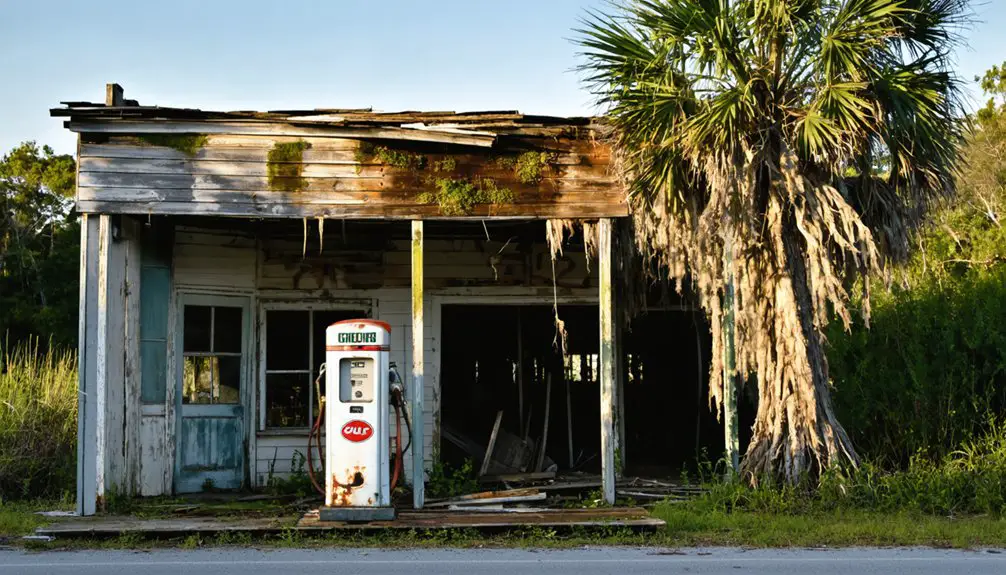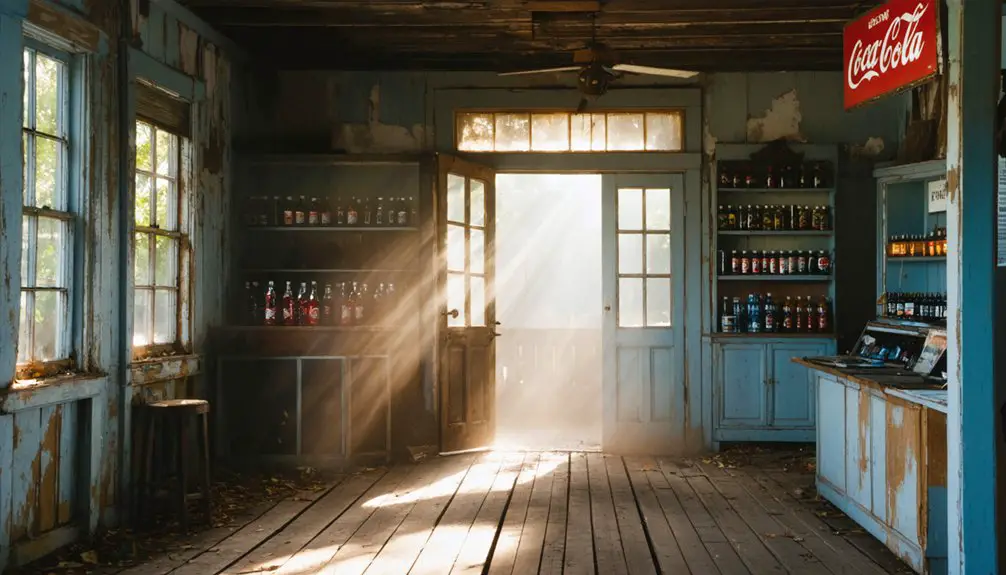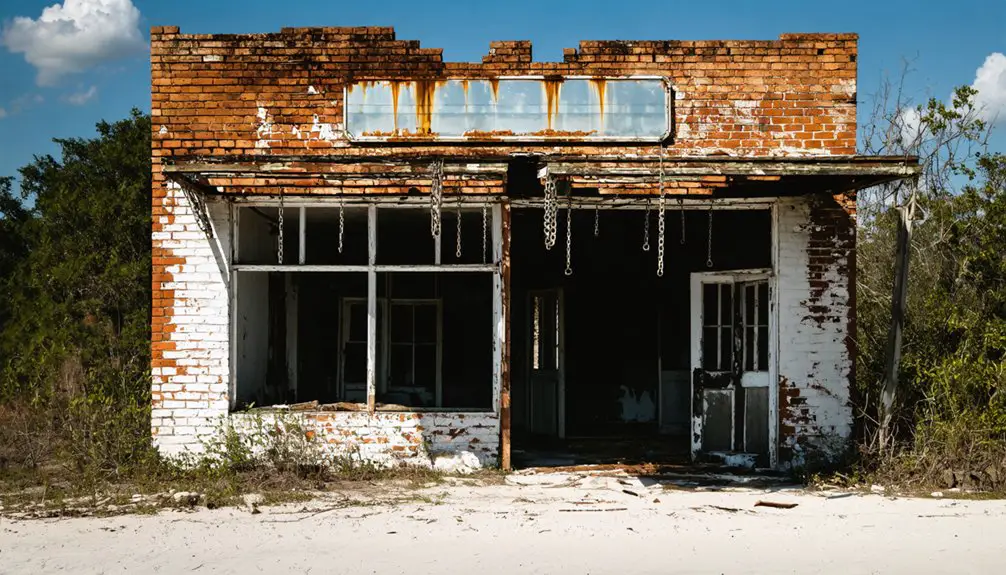You’ll find Chevelier’s remains near Monroe County’s Chevelier Point, where James F. Jaudon’s ambitious 1916 development scheme promised an agricultural paradise at $20 per acre. His Chevelier Corporation acquired 207,360 acres between Miami and Fort Myers, marketing sugarcane plantations and timber resources along the Tamiami Trail. By 1937, environmental challenges and economic hardship forced bankruptcy, and the land transformed into part of Everglades National Park – a story that reveals the true cost of Florida’s speculative frontier.
Key Takeaways
- Chevelier was an ambitious 1916 land development project near Monroe County that failed and became a ghost town by 1937.
- The settlement promised agricultural prosperity at $20 per acre but faced devastating crop failures due to poor soil and flooding.
- Abandoned farms, rusting equipment, and crumbling homesteads mark the former settlement’s location along the Tamiami Trail.
- The Great Depression and bankruptcy forced residents to abandon their agricultural dreams, leaving behind deteriorating infrastructure.
- The ghost town’s land was later incorporated into Everglades National Park in 1947, preserving its story of failed frontier development.
The Rise of a South Florida Dream
While many Florida land developments of the early 1900s promised riches, Chevelier emerged in 1916 as an ambitious venture near Chevelier Point that aimed to transform Monroe County’s wilderness into an agricultural paradise.
Amid Florida’s booming land schemes, Chevelier’s 1916 vision promised to turn untamed Monroe County into fertile farmland paradise.
As a planned community encompassing half a million acres, you’d find land going for just $20 per acre, with sugarcane farming as the primary draw. Similar to the naval aviation training that would later dominate Pensacola’s landscape, Chevelier’s developers had grand visions for transformation.
The developers’ vision extended beyond agriculture, incorporating the preservation of scenic timber resources. You couldn’t miss the project’s cornerstone: the Tamiami Trail, a revolutionary road that would connect Florida’s coasts through the untamed Everglades. The massive undertaking would ultimately cost eight million dollars to complete.
James F. Jaudon, deeply invested in the development, pushed hard to guarantee the Trail’s route would serve Chevelier’s agricultural aspirations, including a special “Loop Road” to maximize the property’s accessibility.
James F. Jaudon’s Grand Vision
You’ll find James F. Jaudon’s 1916 vision for Chevelier exemplified in his grand promises of fertile agricultural land priced at $20 per acre and abundant timber resources totaling 148 million board feet.
Through his Chevelier Corporation and Jaudon Realty Company, he marketed this South Florida paradise as a prime location for sugarcane cultivation, strategically positioned along the emerging Tamiami Trail. The company’s ambitious plans included peat utilization from the Everglades to boost economic development.
Despite his ambitious plans for a half-million-acre agricultural empire, Jaudon’s dream crumbled under economic pressures, leading to bankruptcy in 1937 and the land’s eventual incorporation into Everglades National Park.
Development Dreams and Promises
In 1916, ambitious developer James F. Jaudon launched his grand vision for Chevelier, acquiring 207,360 acres of untamed Everglades land between Miami and Fort Myers.
You’d have witnessed his bold promises of transforming waterlogged wilderness into a thriving agricultural empire, despite looming development challenges and ecological considerations.
- Vast sugarcane plantations stretching across drained wetlands, selling for $20 per acre
- Furniture factories humming with activity, processing 148 million feet of local timber
- Shoe manufacturing plants dotting the landscape along the promised Tamiami Trail
- Sprawling cattle ranges carved from the wild Everglades, creating a new frontier
The Chevelier Corporation marketed this dream aggressively, leveraging Florida’s post-WWI boom and banking on the Tamiami Trail’s completion to unleash the region’s potential for pioneering settlers seeking their fortune.
Marketing the Perfect Paradise
Through sophisticated marketing campaigns, James F. Jaudon’s Chevelier Corporation painted an enticing vision of untapped opportunity in South Florida. His marketing strategies targeted northern investors with promises of vast agricultural potential, highlighting 148 million feet of timber and nearly half a million acres priced at just $20 per acre.
Promotional materials showcased the planned Tamiami Trail as a crucial transportation link to Miami and Fort Myers, positioning Chevelier as a future economic powerhouse.
You’d find grand promises of the world’s largest sugar plantations, furniture factories, and cattle ranges. Jaudon’s pitch balanced industrial ambitions with environmental appeal, assuring preservation of scenic areas.
The dream he sold wasn’t just land – it was a chance to build a self-sufficient paradise where agriculture, manufacturing, and nature could thrive together.
Ambitious Plans Fall Short
Despite James F. Jaudon’s grand vision for Chevelier as a thriving agricultural empire, his ambitious plans crumbled under the weight of harsh realities.
His massive land speculation venture spanning 207,360 acres in Monroe County faced insurmountable infrastructure challenges, from delayed road construction to environmental obstacles. The Chevelier Corporation spent three hundred thirty-three thousand on development before failing.
- Sugarcane plantations meant to flourish on $20-per-acre lots never materialized in the unforgiving Everglades soil.
- Promised furniture and shoe factories stood only as blueprints, their industrial dreams unfulfilled.
- The Tamiami Trail’s completion in 1928 came too late to rescue the failing development.
- Half a million acres of marketed paradise dissolved into bankruptcy by 1937.
The federal government eventually claimed the land for unpaid taxes, and by 1947, Chevelier’s former territory became part of the Everglades National Park, preserving it from future development schemes.
Promises of Agricultural Paradise
You’ll find Chevelier’s agricultural promise was built on aggressive marketing that advertised fertile $20-per-acre parcels ideal for sugarcane and general farming.
The Chevelier Corporation’s promotional materials highlighted half a million acres of land with 148 million feet of timber, while emphasizing the area’s proximity to scenic preserved spaces. Like the Second Empire style architecture seen in similar developments of the era, the town’s buildings reflected an attempt at European sophistication. The Atlantic Coast Line Railroad constructed tracks through the region between 1915 and 1918, spurring development hopes.
The company’s sales pitch capitalized on Florida’s growing reputation as an agricultural frontier, though these promises of farming paradise would ultimately prove hollow.
Failed Farming Dreams
When land promoters painted Chevelier as an agricultural paradise in the early 1900s, they couldn’t have been more mistaken about the area’s farming potential.
You’d have faced devastating farming hardships if you’d settled there – from poor soil fertility to frequent flooding that drowned crops. The harsh Florida climate, along with insufficient irrigation, made successful farming nearly impossible. Like the nearby town of Ellaville’s abandoned ruins, the failed settlement serves as a stark reminder of misplaced agricultural ambitions.
Crop failures became the norm as diseases ravaged tomatoes and sugar cane, while pests destroyed what remained. The area’s struggles mirrored those faced by early settlers like Drew’s sawmill workers who battled difficult environmental conditions.
- Fields of withered sugar cane stalks rotting in waterlogged soil
- Empty barns and abandoned farm equipment rusting in overgrown fields
- Failed irrigation ditches filled with stagnant water and marsh grass
- Broken promises evidenced by crumbling homesteads and untamed wetlands
The Great Depression delivered the final blow, forcing many to abandon their dreams of agricultural prosperity in Chevelier.
Land Sales and Hype
The story of Chevelier’s downfall began with grandiose marketing schemes in the early 1900s.
James F. Jaudon’s Chevelier Corporation set land valuation at $20 per acre, pushing settlement incentives through flashy promotional campaigns that promised an agricultural paradise in the Florida wilderness.
You’d have found their marketing materials packed with enticing claims: 148 million board feet of timber, endless sugarcane potential, and prime agricultural land stretching across half a million acres.
Much like the Roman coins Chevalier collected in his youth, these promotional materials became historical artifacts of unrealized dreams.
They’d tied everything to the upcoming Tamiami Trail, assuring buyers that this infrastructure would transform Chevelier into a thriving hub of commerce.
The corporation backed these promises with maps highlighting scenic areas and literature trumpeting the subtropical climate’s farming advantages. Many of these promotional materials are now preserved as rare digital collections accessible through university archives.
But like many Florida land schemes of the era, Chevelier’s agricultural dreams proved too good to be true.
The Tamiami Trail Connection

Through extensive negotiations in 1919, Chevelier Corporation transformed the Tamiami Trail‘s destiny by proposing an essential reroute through its 207,000-acre holdings in Monroe County.
You’ll find that this pivotal decision came when Lee County couldn’t complete its portion of the trail, leading to a dramatic shift in the road’s path. The construction began in 1921, creating what you now know as Loop Road within Big Cypress National Preserve.
- Bay City Walking Dredges carved through the untamed wilderness
- Three million dynamite sticks blasted through the limestone
- Massive dredging operations created canals alongside the roadway
- Workers battled swamp conditions to lay the foundation
The Chevelier Corporation’s intervention proved significant during early 1920s funding shortages, expediting the eastern section’s completion through private enterprise innovation and resources.
Economic Downfall and Abandonment
Despite initial prosperity from logging and turpentine operations, Chevelier’s economic foundation began crumbling in the mid-1920s as extractive industries depleted local resources.
The town’s fate followed typical economic cycles of Florida’s boom-and-bust communities, where company-controlled wages and limited economic diversification left little cushion against market downturns.
Infrastructure challenges and geographic isolation made recovery nearly impossible once the primary industries faltered. A devastating fire caused roughly one million dollars in damage (in today’s terms) to vital mill operations, while environmental degradation from extensive logging made economic renewal unfeasible.
You’ll find that Chevelier’s decline accelerated as businesses failed and residents fled to seek opportunities elsewhere, leaving behind yet another Florida ghost town born and abandoned by the extractive industry’s temporary promise.
From Private Land to National Park

Following its economic collapse, Chevelier’s destiny took an unexpected turn when businessman James F. Jaudon’s corporation declared bankruptcy in 1937.
The land change marked a shift from private agricultural ambitions to federal ownership as the government acquired the property for unpaid taxes.
You’ll find that by 1947, the area was incorporated into the newly established Everglades National Park, forever changing its purpose from development to conservation.
- Pristine wetlands where sugarcane fields were once planned
- The Tamiami Trail cutting through untamed wilderness
- Protected historical remnants of failed development dreams
- Native flora and fauna reclaiming their ancestral territory
The preservation efforts under federal management have transformed what was meant to be a thriving agricultural community into a protected sanctuary within America’s unique River of Grass, safeguarding both natural and cultural resources for future generations.
Echoes of the Past in Modern Everglades
While Chevelier’s dreams of becoming a thriving agricultural hub vanished, you’ll still find remnants of its ambitious past scattered throughout Everglades National Park today.
The area’s wetland preservation efforts have allowed natural processes to gradually reclaim former drainage systems, while ecological restoration projects focus on reviving the region’s natural water flow.
You’ll discover evidence of historical significance beyond Chevelier’s brief existence – archaeological findings reveal shell middens, canals, and village sites from indigenous history, particularly the sophisticated Calusa civilization.
Today, conservation efforts protect both cultural heritage and biodiversity impact, as the park’s interpretive programs weave together stories of human settlement attempts with the enduring natural landscape.
The ghost town’s footprint serves as a powerful reminder of nature’s resilience against development ambitions.
Lessons From a Failed Frontier

The ambitious story of Chevelier offers stark warnings about the perils of unchecked land speculation in early 20th-century Florida.
You’ll find that James F. Jaudon’s dream of transforming Everglades swampland into a thriving agricultural community crashed against harsh environmental realities. Without proper environmental assessments, speculative investments of $20 per acre proved disastrous when the promised boom never materialized.
Jaudon’s grand vision faltered as environmental realities overtook speculative dreams, leaving $20-per-acre investments to sink into the Everglades marsh.
- Wooden boardwalks sinking into murky swamp waters
- Abandoned sugarcane fields reclaimed by saw grass
- Weathered “For Sale” signs fading in the subtropical sun
- Empty drainage canals filling with native wildlife
Today, as you walk through what’s now protected parkland, you’re witnessing nature’s reclamation of a failed frontier – a reminder that even the boldest development plans must respect Florida’s unique ecological constraints.
Frequently Asked Questions
Are There Any Remaining Structures or Ruins Visible in Chevelier Today?
You’ll find only scattered brick foundations and deteriorated walls as remaining structures in the dense woods, with visible ruins showing heavy water damage and vegetation overtaking what’s left of the former town.
What Happened to the Original Residents Who Purchased Land in Chevelier?
After losing $20-per-acre investments, you’d have seen original landowners forfeit their properties to federal authorities in 1937. Most residents were forced to migrate when bankruptcy ended private land ownership.
How Much Did the Chevelier Corporation Owe in Back Taxes?
You won’t find specific tax implications or corporate debts documented in public records, though Florida Department of Revenue’s procedures indicate Chevelier Corporation likely owed enough to trigger collection actions and penalties.
Were There Any Successful Harvests or Farming Operations Before Abandonment?
You won’t find much evidence of successful crops in Chevelier since it wasn’t primarily a farming town. Unlike nearby Venus’s cattle and citrus operations, Chevelier focused on logging and milling before its eventual abandonment.
What Indigenous Peoples Originally Inhabited the Chevelier Area Before Development?
You’ll find rich cultural heritage in the Muscogee (Creek) peoples, including Hitchiti-speaking Oconees and Apalachicola bands, who maintained indigenous traditions in this region before European settlement forced their removal.
References
- https://en.wikipedia.org/wiki/Chevelier
- https://en.wikipedia.org/wiki/Phantom_Manor
- https://www.youtube.com/watch?v=0TLWOUfei-M
- https://www.youtube.com/watch?v=3mDsPKA4B2o
- https://thingstodoinfla.wordpress.com/2016/04/23/the-ghost-town-of-ellaville/
- https://floridaseminoletourism.com/the-seminoles-floridas-original-tourism-entrepreneurs-part-3/
- https://cnrse.cnic.navy.mil/Installations/NAS-Pensacola/About/History/
- https://destroyerhistory.org/fletcherclass/ns_chevalier/
- https://watermarkonline.com/2024/12/12/remarkable-people-2024-chevalier-chev-lovett-florida-rising-chief-operating-officer/
- http://dpanther.fiu.edu/sobek/content/JJ/00/06/00/02/00001/file8.pdf



